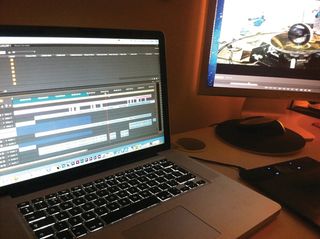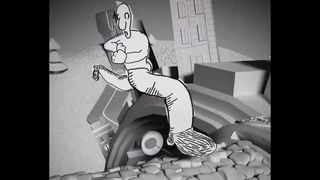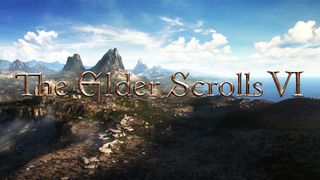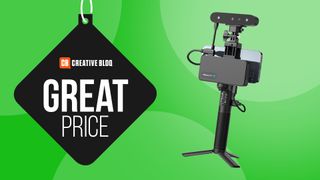Space-exploring animation turns VFX artist into Hollywood director
Hasraf Dulull reveals how Adobe’s product range could help you to realise your dream of being a filmmaker.
I didn't go to film school, or attend regular film festivals or film launch parties. I am self-taught and through my career as a VFX supervisor I was exposed to the world of filmmaking. I didn't have inroads to being a film director before I made my sci-fi short film Project Kronos, which became a hit online when released in April 2013. This instantly led to me being signed to a Hollywood manager and a feature film deal with a studio soon followed.
From my experience with Project Kronos, it is clear that short films are very powerful tools, to not only tell your story, but also as 'proof of concept' for first-time filmmakers to instil confidence in a studio executive to take an interest in the project and you.
And the great thing is, now anyone can do it too: I don't think I would have been able to achieve the vision in Project Kronos ten years ago when VFX technology was expensive and high-end tools were not easily accessible.

VFX tools for the masses
Project Kronos was created entirely inside Adobe Creative Cloud on a Mac Book Pro laptop, where I was able to write, direct, edit and create the visual effects myself, with some support from 3D artists contributing components in the shots.
This is a testament to the power of VFX technology and tools, but also the future of filmmaking, where the 'conventional' ways of making films no longer need to be the barrier to getting your vision made, either by yourself or with a small crew, inexpensively: you still have that high production value and polish you get on feature films.
Here I am going to break down my workflow from Project Kronos, using Adobe Creative Cloud tools. As with all projects it all starts off with the script – as they say: "The script is King!".

I used Adobe Story, which was useful for creating and managing script development as it's both an online and offline tool. However, I soon realised I could also use it as a production database for storing my ideas, script versions and research material. I typically tend to be very visual even while writing, so I will usually knock up style frames in the form of pre-viz concept boards using Photoshop.
Once the script is locked, I then start approaching actors and crew, but just having a script is not enough to entice talent to join the venture for a self- funded project, so I package up all my style frames and script notes into a PDF using Adobe Acrobat and then send this out to garner interest. Working in this manner enables the recipient to really understand the project and what I might expect of them.
The 'conventional' ways of making films no longer need to be the barrier to getting your vision made
When shooting on set, I like to be able to see my dailies instantly in an edit timeline, so I usually have a DIT (Digital Imaging Technician) on set who would be able to gather the raw footage using Adobe Prelude, log it and run it in a sequence inside Adobe Premiere. Then the crew and I can review during setups of the scenes throughout the day. This also means at the end of a day's shoot I can take the material home on a hard drive and continue to work.
The editing process is my favourite part; where I really craft the film. For me, it's where the film is made. I use Adobe Premiere to edit, but also using its Dynamic Link feature, I am able to pick a shot in the edit and right-click and load that into Adobe After Effects to create VFX, keeping the right number of frames and applying editorial effects.
Saving the budget
I tend to make 80 to 95 per cent of the VFX in my films, and I bring in other VFX artists when needed. For Project Kronos, a few CG artists were tasked to create CG components, such as the Probe itself and some of the motion graphics, which I would then take as renders with alpha, and use as elements throughout my composites in After Effects.
This was just one of the ways I was able to use my VFX budget for external help. I chose to get components made rather than shots, as that gave me flexibility to create as many shots as I liked myself. For example, I assigned French VFX studio Dwarf Labs to create the Space Probe for me and asked that every part on the model was animating and spinning, but the whole probe was to stay fixed in the centre of the frame, and to render it out at 2K so I could push in if needed and also at a duration of 500 frames so that I could re-time and do things editorially.
As I was using one rendered element in all the space shots featuring the probe, I was able to animate the scale in 2D moving up or away from the viewer and it still felt like a 3D move because of the optical illusion created with everything in the element moving, even though I was only animating the transform, scale and rotation.
From Nuke to After Effects
For a good few years I've been involved in doing technical demos for Nuke, so when people heard I was using After Effects to create the short film, which had a very photographic VFX nature to it, they were a little surprised.
The only thing I can say to that is that the tools are different, but the way you approach the VFX is fundamentally the same, for example, when you need to remove a rig, you have to create a clean plate; you need to do tracking, rotoscoping and paint work. The same workflow applies to any compositing tool you use whether it’s Nuke, Flame or After Effects.
To create the cinematic polished look of the film, I used Adobe Speedgrade; it's like having a post- production colourist tool on your laptop. I was able to create LUTs (look up tables) and share them, and bring them into Premiere.

I didn't have to render out frames to take into VFX, or render out the edit into frames to then take into Speedgrade; my final render of the film came out of the edit, saving on disk space and time. Any workflow that speeds up production in an efficient way means you save a lot on budget, allowing you to create high concept content in an indie way.
Films being made by small teams now have the same level of polish and production value as high- budget studio movies. This hasn't gone unnoticed by Hollywood either: as it looks for economical ways to make hit movies, it's no surprise that Hollywood's contacting anyone who can make a sci-fi movie, complete with stunning visual effects, for the price of a laptop.
Words: Hasraf Dulull
Project Kronos was a runner-up in the VFX Film Short category in 3D World's 2014 CG Awards. Read more about this and the winners in all the other categories 3D World issue 187 – on sale now!
This article originally appeared in 3D World issue 181.

Thank you for reading 5 articles this month* Join now for unlimited access
Enjoy your first month for just £1 / $1 / €1
*Read 5 free articles per month without a subscription

Join now for unlimited access
Try first month for just £1 / $1 / €1
Get the Creative Bloq Newsletter
Daily design news, reviews, how-tos and more, as picked by the editors.
The Creative Bloq team is made up of a group of design fans, and has changed and evolved since Creative Bloq began back in 2012. The current website team consists of eight full-time members of staff: Editor Georgia Coggan, Deputy Editor Rosie Hilder, Ecommerce Editor Beren Neale, Senior News Editor Daniel Piper, Editor, Digital Art and 3D Ian Dean, Tech Reviews Editor Erlingur Einarsson and Ecommerce Writer Beth Nicholls and Staff Writer Natalie Fear, as well as a roster of freelancers from around the world. The 3D World and ImagineFX magazine teams also pitch in, ensuring that content from 3D World and ImagineFX is represented on Creative Bloq.
Related articles
-

-

-

-

